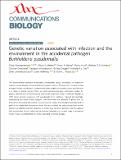Files in this item
Genetic variation associated with infection and the environment in the accidental pathogen Burkholderia pseudomallei
Item metadata
| dc.contributor.author | Chewapreecha, Claire | |
| dc.contributor.author | Mather, Alison E. | |
| dc.contributor.author | Harris, Simon R. | |
| dc.contributor.author | Hunt, Martin | |
| dc.contributor.author | Holden, Matthew T. G. | |
| dc.contributor.author | Chaichana, Chutima | |
| dc.contributor.author | Wuthiekanun, Vanaporn | |
| dc.contributor.author | Dougan, Gordon | |
| dc.contributor.author | Day, Nicholas P. J. | |
| dc.contributor.author | Limmathurotsakul, Direk | |
| dc.contributor.author | Parkhill, Julian | |
| dc.contributor.author | Peacock, Sharon J. | |
| dc.date.accessioned | 2019-11-27T16:30:02Z | |
| dc.date.available | 2019-11-27T16:30:02Z | |
| dc.date.issued | 2019-11-22 | |
| dc.identifier.citation | Chewapreecha , C , Mather , A E , Harris , S R , Hunt , M , Holden , M T G , Chaichana , C , Wuthiekanun , V , Dougan , G , Day , N P J , Limmathurotsakul , D , Parkhill , J & Peacock , S J 2019 , ' Genetic variation associated with infection and the environment in the accidental pathogen Burkholderia pseudomallei ' , Communications Biology , vol. 2 , 428 . https://doi.org/10.1038/s42003-019-0678-x | en |
| dc.identifier.issn | 2399-3642 | |
| dc.identifier.other | PURE: 263713707 | |
| dc.identifier.other | PURE UUID: 97940916-5555-4d38-8318-ccecddfa6973 | |
| dc.identifier.other | RIS: urn:D1EDD68BDBFA727EC9CF7657364155D7 | |
| dc.identifier.other | RIS: Chewapreecha2019 | |
| dc.identifier.other | ORCID: /0000-0002-4958-2166/work/65345429 | |
| dc.identifier.other | Scopus: 85075727834 | |
| dc.identifier.other | WOS: 000498022700002 | |
| dc.identifier.uri | https://hdl.handle.net/10023/19012 | |
| dc.description.abstract | The environmental bacterium Burkholderia pseudomallei causes melioidosis, an important endemic human disease in tropical and sub-tropical countries. This bacterium occupies broad ecological niches including soil, contaminated water, single-cell microbes, plants and infection in a range of animal species. Here, we performed genome-wide association studies for genetic determinants of environmental and human adaptation using a combined dataset of 1,010 whole genome sequences of B. pseudomallei from Northeast Thailand and Australia, representing two major disease hotspots. With these data, we identified 47 genes from 26 distinct loci associated with clinical or environmental isolates from Thailand and replicated 12 genes in an independent Australian cohort. We next outlined the selective pressures on the genetic loci (dN/dS) and the frequency at which they had been gained or lost throughout their evolutionary history, reflecting the bacterial adaptability to a wide range of ecological niches. Finally, we highlighted loci likely implicated in human disease. | |
| dc.format.extent | 11 | |
| dc.language.iso | eng | |
| dc.relation.ispartof | Communications Biology | en |
| dc.rights | Copyright © 2019 The Author(s). Open Access. This article is licensed under a Creative Commons Attribution 4.0 International License, which permits use, sharing, adaptation, distribution and reproduction in any medium or format, as long as you give appropriate credit to the original author(s) and the source, provide a link to the Creative Commons license, and indicate if changes were made. The images or other third party material in this article are included in the article’s Creative Commons license, unless indicated otherwise in a credit line to the material. If material is not included in the article’s Creative Commons license and your intended use is not permitted by statutory regulation or exceeds the permitted use, you will need to obtain permission directly from the copyright holder. To view a copy of this license, visit http://creativecommons.org/licenses/by/4.0/. | en |
| dc.subject | QH426 Genetics | en |
| dc.subject | DAS | en |
| dc.subject | SDG 3 - Good Health and Well-being | en |
| dc.subject.lcc | QH426 | en |
| dc.title | Genetic variation associated with infection and the environment in the accidental pathogen Burkholderia pseudomallei | en |
| dc.type | Journal article | en |
| dc.description.version | Publisher PDF | en |
| dc.contributor.institution | University of St Andrews. School of Medicine | en |
| dc.contributor.institution | University of St Andrews. Biomedical Sciences Research Complex | en |
| dc.contributor.institution | University of St Andrews. Infection and Global Health Division | en |
| dc.contributor.institution | University of St Andrews. Infection Group | en |
| dc.identifier.doi | https://doi.org/10.1038/s42003-019-0678-x | |
| dc.description.status | Peer reviewed | en |
This item appears in the following Collection(s)
Items in the St Andrews Research Repository are protected by copyright, with all rights reserved, unless otherwise indicated.

